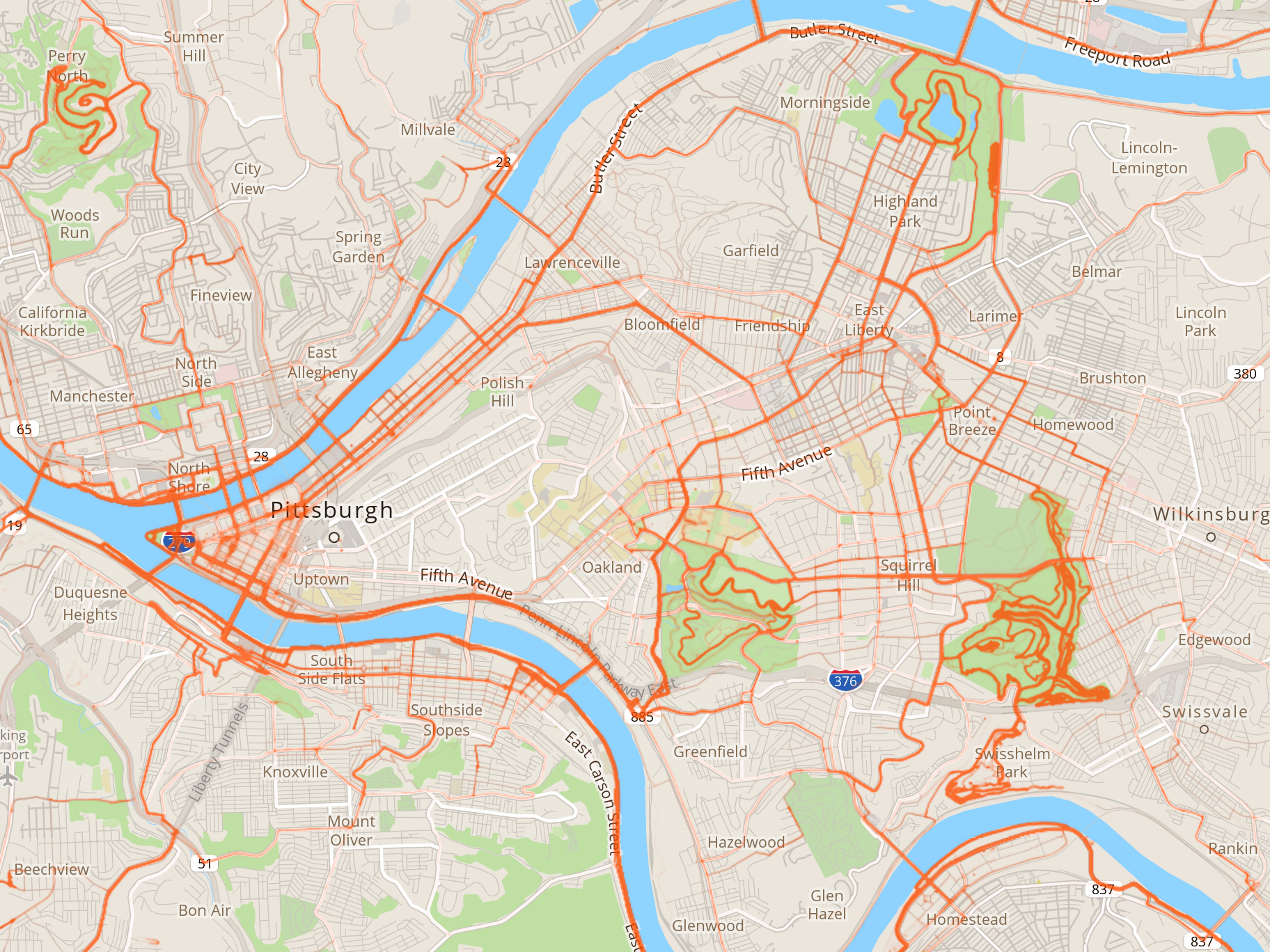These maps are really interesting.
But I think the way that Strava (and bikemaps.org) visualize cyclist volume is fundamentally flawed: it is skewed toward emphasizing curving or slow routes (e.g. traveled by mountain bikers) and de-emphasizing straight, fast routes (e.g. by road riders).
It appears that Strava creates their heatmaps by placing dots on the map for each data point coming from the GPX (or other) input files, and that Strava never gave much thought to what exactly they were visualizing, so they’re not normalizing the input data. Some info on their maps here:
http://engineering.strava.com/global-heatmap/. They're more focused on systems details than statistical concepts.
If you were to add one dot for each unit distance traveled, that would give you a map where color shows the number of cyclists passing a given point. I think that’s the visualization most people would want to see. Let’s call that “unweighted statistics”. If you were to add one dot for each unit time, that would tend to emphasize places where people bike slowly (e.g. hills, rough surface) or stop (e.g. coffee shops, homes). Let’s call this “time-weighted statistics”; it would tell you the probability of finding a Strava enthusiast at a given location. If the GPS sensor is noisy, I imagine the track would tend toward time-weighted statistics. The GPX files generated by my Garmin Oregon 450 contain point sets that are neither of these two, but appear to have had collinear points filtered out. We could call this “curve-weighted statistics”, since it generates more points on curves and fewer on straightaways.
Since most GPS devices seem to output time- or curve-weighted statistics, and Strava doesn’t seem to be normalizing the data points it gets as input, but is displaying them raw, Strava is giving us a time- or curve-weighted map. Strava should normalize their maps to be unweighted.
Of course, there are other biases to Strava’s maps, e.g. weighted toward competitive people with money and time to burn, but those are harder to fix.
 more detail
more detail  more detail
more detail 
 Similarly, Strava usage patterns represent cycling by QuantifiedSelf-type cyclists with smart phones. That demographic is skewed by income and discretionary time, which brings class and race into the picture.
So for instance, poor people riding to work on cheap beater bikes is not in anyway reflected in Strava numbers. This is an important component of bikes-as-transit that would be completely ignored if we use Strava data to plan bike infrastructure.
But Strava is a business, with something (data) to sell - and they package it and hype it, there's no alternative dataset, and uninformed politicians purchase the data and rely on it.
Final geek aspect: Strava is selling data, not information or knowledge.
We now return you to the thread in progress.
Similarly, Strava usage patterns represent cycling by QuantifiedSelf-type cyclists with smart phones. That demographic is skewed by income and discretionary time, which brings class and race into the picture.
So for instance, poor people riding to work on cheap beater bikes is not in anyway reflected in Strava numbers. This is an important component of bikes-as-transit that would be completely ignored if we use Strava data to plan bike infrastructure.
But Strava is a business, with something (data) to sell - and they package it and hype it, there's no alternative dataset, and uninformed politicians purchase the data and rely on it.
Final geek aspect: Strava is selling data, not information or knowledge.
We now return you to the thread in progress.
 this is a Strava bike heat-map of Meyersdale PA, with the three hot spots identified
this is a Strava bike heat-map of Meyersdale PA, with the three hot spots identified
 which leaves me thinking, it's not a bad way to find out where "some" (a-r) cyclists go in a strange town.
which leaves me thinking, it's not a bad way to find out where "some" (a-r) cyclists go in a strange town.
